Bmw P1 Hybrid
► Combining electricity and petrol
► The fastest hybrids you can drive
► Hybrid tech is also used in F1
Gone are the days when hybrid technology was synonymous with the Toyota Prius and others of its ilk. While hybrid drivetrains still serve to lower tailpipe emissions and improve efficiency by combining a battery and electric motor with a petrol engine, the technology is also being exploited by supercar and hypercar makers to boost performance.
The 'hypercar Holy Trinity' of the previous decade, comprising the McLaren P1, Porsche 918 Spyder and Ferrari LaFerrari, were among the first to show how a motor and battery can fill gaps in an engine's torque curve with surges of electricity, improve handling with clever torque vectoring, and even let £1million+ hypercars drive silently in fully-electric mode for short distances.
Hybrid cars: further reading
- How does a hybrid car work? The jargon decoded
- How much does it cost to run a hybrid car?
- The best electric cars you can buy in 2021
Today, hybrid drivetrains are increasingly used to meet ever-tightening emissions legislation, while still producing massive power. The latest entrants to the hybrid supercar club are the upcoming Ferrari 296 GTB and McLaren Artura, which both make use of all-new V6 engines alongside electric motors and batteries to offer hypercar performance and over a dozen miles of pure-EV driving.
The fastest hybrid cars
Often using technology borrowed from the race track, here are the quickest-accelerating hybrid sports and supercars on sale today, plus those coming in the next few months.
1. Ferrari SF90 Stradale
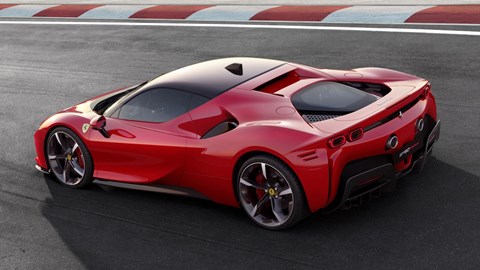
- 0-62mph: 2.5 seconds
- Power: 986bhp
- Price: £450,000
- Top speed: 211mph
Meet Ferrari's new halo model, the SF90 Stradale. Named after Ferrari's 2019 Formula One car but with the Stradale or 'street' suffix, it's the fastest road car Maranello has ever made – and yes, it's a hybrid. The SF90 Stradale uses a 769bhp, 4.0-litre V8 and combines it with a 7.9kWh battery and three electric motors, worth an additional 217bhp. Put the two together and you get a topline figure of 986bhp, a top speed of 211mph, and most importantly here, a 0-62mph sprint time of just 2.5 seconds. It's still practical though; the Stradale will do 16 miles of electric only driving.
2. Aston Martin Valkyrie
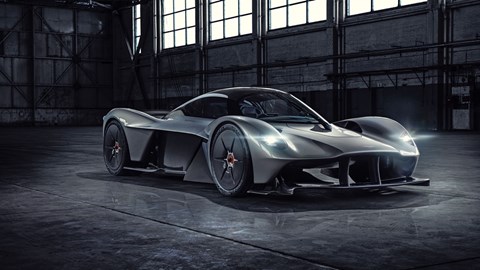
- 0-62mph: 2.5 seconds (estimate)
- Power: 1140bhp
- Price: £2-3m
- Top speed: 217mph
Likely to set a new yardstick in road car performance, the Aston Martin Valkyrie is the brainchild of Adrian Newey, chief technical officer of the Red Bull Formula One team. Built without the need to comply with F1 rules, the Valkyrie is powered by a naturally aspirated, 6.5-litre Cosworth V12 engine and battery hybrid system, which delivers a total power output of 1,140bhp.
The battery system, which works in a similar way to the KERS of a Formula One car, is built by Rimac, the Croatian automotive company which also produced its own limited-run electric hypercar, the Nevera.
Aston Martin is yet to announce the Valkyrie's official 0-60mph time, but it will likely be around 2.5 seconds. The top speed of the Valkyrie Coupe, of which just 150 will be built, is 217mph. The Spyder, limited to just 85 examples, has the same top speed with its roof panel in place, but this lowers to 205mph when driving with the wind in your hair. A track-only version called the Valkyrie AMR is expected to reach 250mph.
3. McLaren Speedtail
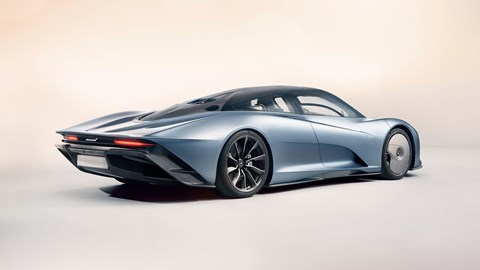
- 0-62mph: 3.0 seconds
- Power: 1,036bhp
- Price: £2.1m
- Top speed: 250 mph
Intended to be a 21st century reimagining of the legendary McLaren F1 of the Nineties, the Speedtail is a three-seat hypercar with a goal of combining ultimate luxury and cross-continental comfort with a top speed of 250 mph.
The car is powered by a twin-turbocharged 4.0-litre V8 and an electric motor sending 747bhp and 309bhp respectively, for a total combined output of 1,036bhp and 848 lb ft of torque, to the rear wheels. McLaren's acceleration stats claim a 0-62mph time of 3.0 seconds, 124mph in 6.6 seconds, 186mph in 13.0 seconds, and a top speed of 250mph.
Inside, the Speedtail has a three-seat layout with the driver sitting in the middle, flanked by two lucky passengers. McLaren is pitching the Speedtail as a 'hyper GT' car, capable of high speed, but delivering it in a more refined, comfortable and luxurious way than the more hardcore, track-biased McLaren Senna.
4. Mercedes-AMG One
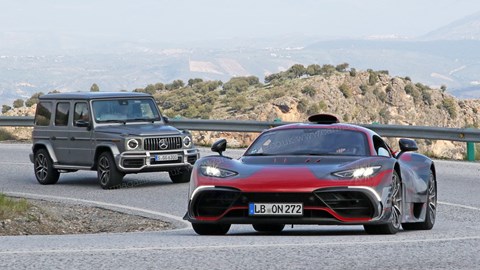
- 0-62mph: 2.5 seconds (estimate)
- Power: c1,000bhp
- Top speed: 217+mph
- Price: £2m
Announced back in 2017 and delayed repeatedly, the Mercedes-AMG One is now almost ready to enter production, which is set to happen in 2022. Delays stem from the car's engine, which is said by Mercedes to be closely related to that of its F1 car.
This means a turbocharged, 1.6-litre V6 engine with four electric motors (compared to one in the F1 car), all-wheel-drive, and a total output in the region of 1,000bhp. Mercedes-AMG states a 0-124mph time of less than 6.0 seconds and a top speed in excess of 217mph.
Adapting an F1-spec engine for road use is no mean feat, with Mercedes-AMG boss Philipp Schiemer describing the car as the most difficult project his company has ever worked on. Despite revealing the One back in 2017, the first of the 275 examples to be built isn't expected to arrive on buyer's driveways until the second half of 2022 – giving them plenty of time to save up for the £2 million-plus list price.
5. Porsche 918 Spyder
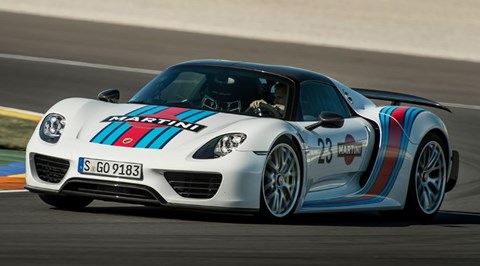
- 0-62mph: 2.6 seconds
- Power: 875bhp
- Top speed: 211 mph
- Price: £781,000
The final member of the Holy Trinity is the only to have a removable roof and all-wheel-drive. The Porsche is powered by a 4.6-litre V8 plus a 277 bhp electric motor - a far larger amount of electrical assistance than offered by the McLaren and Ferrari.
An electric-only mode delivers up to 18 miles of zero-emission driving at up to 93mph. The complex electrical system delivers power to both the front and rear axles, aiding traction of the line and grip through corners.
Limited to 918 examples, the 918 Spyder was offered with the optional £58,000 Weissach package, which added lightweight wheels, an Alcantara-trimmed interior, and a 40kg reduction in overall weight. Porsche claims this takes the car's 0-186 mph time down from 22 to 19.1 seconds.
6.Lamborghini Countach LPI 800-4
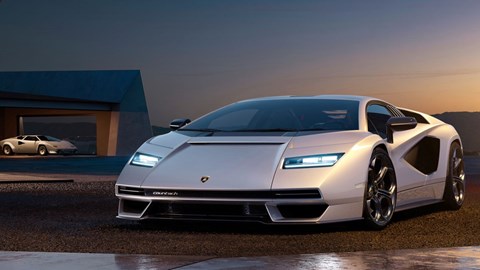
- 0-62mph: 2.8 seconds
- Power: 803bhp
- Top speed: 221mph
- Price: £1.9m
A retro-styled nod to the original Countach of the Seventies, the LPI 800-4 shares its platform with the Aventador and Sián, meaning a naturally-aspirated V12 engine and 48V electric motor fitted to the gearbox, producing a total output of 803bhp.
The motor is powered by a supercapacitor that is claimed to produce three times the power of a lithium battery of the same weight. Instead of reducing emissions and offering pure-EV driving, the supercapacitor acts to smooth out the acceleration curve and deploy torque fill between gear changes.
Lamborghini claims a 0-62mph for the new Countach of 2.8 seconds, a 124mph sprint time of 8.6 seconds, and a top speed of 221mph. Just 112 examples will be produced.
7 .McLaren P1
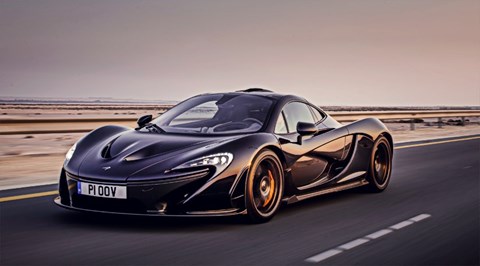
- 0-62mph: 2.8 seconds
- Power: 903bhp
- Top speed: 217 mph
- Price: £866,000
The year 2013 was an important moment in the history of the supercar, as it saw the launch of the McLaren P1, Ferrari LaFerrari, and Porsche 918 Hybrid – the first supercars to come with hybrid drivetrains.
The McLaren P1 combined the power of a 3.8-litre twin-turbocharged V8 with a 4.7 kWh battery pack and a 176bhp electric motor, resulting in a total output of 903bhp.
Limited to 375 units, the P1 can operate in electric-only mode for a handful of miles, but the primary purpose of the electric motor is to offer what McLaren calls 'torque fill'. This is where the motor assists the engine through any flat points in its torque curve, helping to produce a seamless surge of acceleration.
As well as its hybrid drivetrain, the P1 also caused a stir with its dramatic Race Mode, which drops the ride height and raises the huge rear wing to a 29-degree angle of attack, which helps produce 600 kg of total downforce.
8. Lamborghini Sian FKP 37
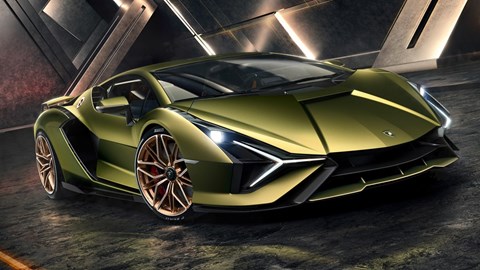
- 0-62mph: 2.8 seconds
- Power: 808bhp
- Top speed: 217+mph
- Price: £2.6m
As the rest of the Volkswagen Group marches towards full electrification, Lamborghini has held on firmly to its 6.5-litre, naturally-aspirated V12. So much so that, for its first hybrid, the Sant'Agata firm installed a supercapacitor instead of a more conventional lithium battery pack.
Lighter and more power-dense, the supercapacitor isn't used for zero-emissions driving or improved efficiency; instead, it delivers 33bhp to help smooth out gear changes and fill gaps between upshifts. Instead of plugging in, the mild hybrid system is charged through regenerative braking. The result is 808bhp, a claimed 0-62mph time of 2.8 seconds, a top speed of over 217mph and in-gear acceleration improvements of up to 20 percent. Lamborghini intends to produce just 63 examples before switching to a more conventional hybrid system for later models.
9.Koenigsegg Regera
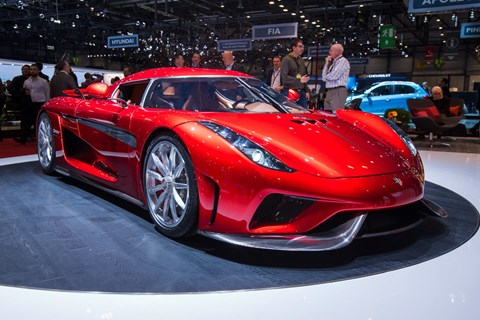
- 0-62mph: 2.8 seconds
- Power: 1,479bhp
- Top speed: 250mph
- Price: c£2m
The Koenigsegg Regera is perhaps as left-field as it gets when it goes to hybrid supercars. In production since 2016, the Regera has a 5.0-litre, twin-turbocharged V8 producing 1,160bhp, plus three electric motors delivering a further 220bhp to the crankshaft and 240bp to each rear wheel. Since the engines and motors of hybrid cars don't produce peak power at the same time, the combined total output of the Regera is 1,479bhp and 1,475lb ft.
That's all very impressive, but the real kicker here is how there's no gearbox. Or rather, there is just one forward gear. The in-house Koenigsegg Direct Drive system is a bit like a torque converter, where the engine and motors all drive a single gear. The result is a 0-62mph sprint of 2.8 seconds and a top speed of 250mph – and phenomenal in-gear acceleration highlighted by 0-186mph in 11 seconds, 0-250mph in 20 seconds and 90-155mph in 3.2 seconds.
10.Ferrari 296GTB
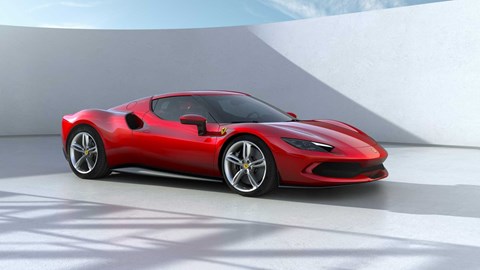
0-62mph: 2.9 seconds Power: 819bhp Top speed: 205 mph Price: £231,000
Ferrari's new V6-powered 296 GTB is its first mainstream hybrid, sitting well below the limited-run LaFerrari and SF90 Stradale flagship. But don't for a minute think the smaller numbers and reduced capacity means the 296 GTB is some kind of slouch.
The twin-turbocharged 3.0-litre V6 produces 654bhp all by itself – a record 218bhp per litre – and is joined by a 7.45kWh battery pack and 164bhp electric motor. Total output is 819bhp – or an improvement of over 100bhp on the F8 Tributo.
Total combined torque is 546lb ft and Ferrari states a 0-62mph time of 2.9 seconds, plus a top speed of 205mph. An all-electric mode offers a zero-emissions range of up to 16 miles at speeds of up to 84mph. The 296 GTB is priced from £231,000.
11. Ferrari LaFerrari
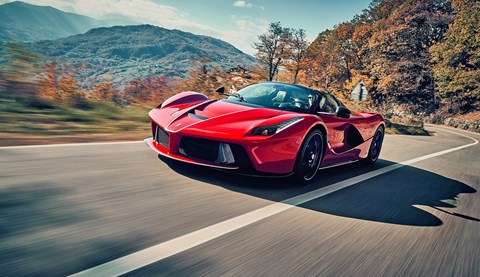
- 0-62mph in sub-3.0 seconds
- Power: 989bhp
- 217+mph
Ferrari's egotistically-named answer to the P1 is the LaFerrari. This also uses a petrol and hybrid power system to push out over 900bhp, achieve a sub-three-second 0-62mph, and exploit electric propulsion for increased performance.
In this case, we have a 6.2-litre naturally-aspirated V12 with a 160bhp electric motor and battery pack. Unlike the relative newcomer of McLaren, the LaFerrari can trace its bloodline back to the 288 GTO of the mid-Eighties, via the F40, F50 and Enzo. Ferrari built 499 examples of the LaFerrari, plus 210 of the Aperta version, which has a removable roof.
Using KERS technology borrowed from the F1 team, the LaFerrari's engine, motor and battery work as one, with energy constantly being harvested back into the battery when braking, but also via use of the traction control system and E-Diff.
12. McLaren Artura
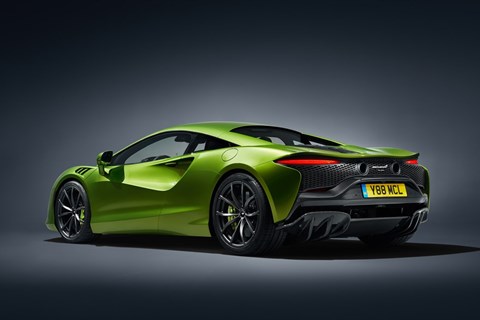
- 0-62mph: 3.0 seconds
- Power: 671bhp
- Top speed: 205mph
- Price: £185,555
McLaren's answer to the Ferrari 296 GTB, the Artura is also a twin-turbocharged, 3.0-litre, V6-powered plug-in hybrid supercar for 2022. In this case, we have a total combined output of 671bhp and 531lb ft, a 0-62mph time of 3.0 seconds, 0-124mph in 8.3 seconds, and a top speed of 205mph. An all-electric range of 18.6 miles from the 7.4kWh battery pack beats the Ferrari by a couple of miles.
The Artura is a hugely important car for McLaren, as it represents the first page of the company's second chapter, and has the first all-new powertrain since the MP4-12C arrived back in 2011.
13. Honda NSX
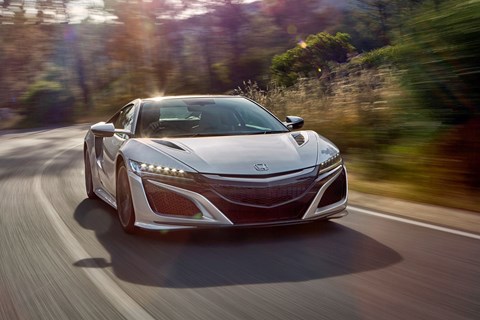
- 0-62mph: 3.0 seconds
- Power: 572bhp
- Top speed: 191 mph
- Price: £145,000
A 2016 revival of the Nineties' original made famous by Ayrton Senna playing a part in its development, the second-generation Honda NSX has stolen a march on many of its rivals in the circa £150,000 supercar category. See our Honda NSX video review here.
While we wait for hybrid supercars from the likes of Ferrari, Lamborghini and Aston Martin, Honda has given the NSX a 3.5-litre twin-turbo V6 engine with three electric motors.
Two of these motors independently drive the front wheels, giving the car all-wheel-drive, but also allowing for trick yaw control, as the car's computer shuffles torque between the front wheels during cornering. Under acceleration the system works like a McLaren P1, helping the engine and filling gaps in the torque curve.
Combined power output from the engine and three motors is 572bhp, which is enough to launch the car to 60mph in three seconds, before reaching a top speed of 191mph.
Once the battery is sufficiently charged (by harvesting energy through regenerative braking) the £145,000 NSX can be driven emission-free in its all-electric mode, but only for a handful of miles.
14. Porsche Panamera Turbo S E-Hybrid
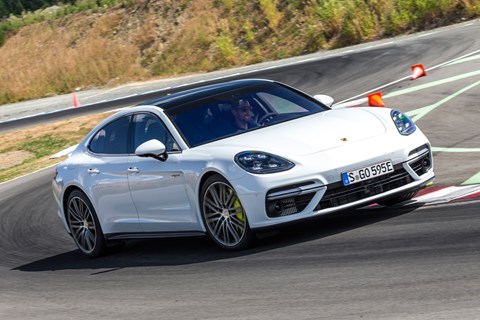
- 0-62mph: 3.2 seconds
- Power: 690bhp
- Top speed: 196 mph
- Price: £141,710
If the all-electric Taycan isn't for you, Porsche's flagship plug-in hybrid offering is the Panamera Turbo S E-Hybrid. This four-door saloon combines a 4.0-litre turbocharged V8 petrol engine with a 134bhp electric motor to produce a combined 690bhp.
This means a 0-62mph time of a McLaren F1-matching 3.2 seconds, a top speed of 196 mph, and the ability to drive in fully-electric mode for up to 31 miles at up to 87mph.
The car can top up its 17.9 kWh battery via regenerative braking, or it can be plugged in and filled in as little as 2.5 hours at a high-speed public charger.
15. Polestar 1
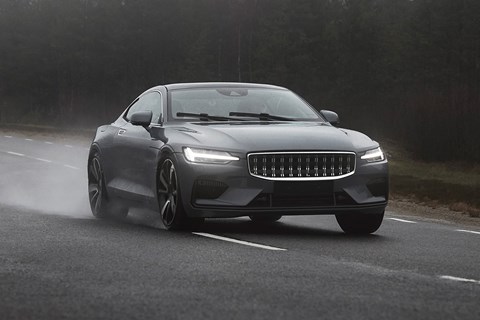
- 0-62mph: 3.9 seconds
- Top speed: 155mph
- Price: £139,000
Formerly the performance division of Volvo, Polestar is a fellow Swedish carmaker and owned by Chinese automotive giant Geely (which also owns Volvo, Lotus and the London Electric Vehicle Company, makers of electric taxis). The Polestar 1 is a limited-run halo car for the new brand, with a unique plug-in hybrid drivetrain comprising a 2.0-litre, four-cylinder engine that is both turbocharged and supercharged.
This is joined by a large 34kWh battery pack good for an electric-only range of 77 miles, while the total combined output is 592bhp and 737lb ft. That's enough shove for a 0-62mph time of 3.9 seconds and a top speed limited to 155mph.
The front-mounted engine is used to drive the Polestar 1's front wheels, while the electric motors send their power to the rear wheels, thus enabling all-wheel-drive and intelligent torque vectoring to improve handling.
A carbon-bodied 2+2 seater, the Polestar 1 is limited to 1,500 examples worldwide, with the final 25 finished in an exclusive matte-finish gold.
16. BMW i8 Coupe
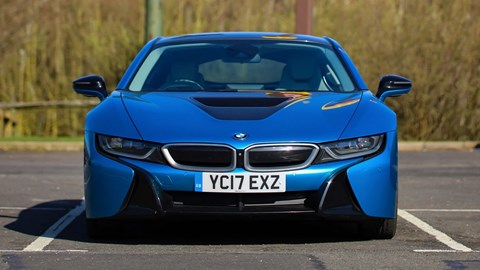
- 0-62mph: 4.4 seconds
- Top speed: 155 mph
- £114,935
Taking a similar approach to hybridisation as the Honda NSX, the BMW i8 does so with a far more reserved 1.5-litre, three cylinder turbocharged engine sourced from Mini, plus a pair of electric motors powering the front wheels.
Despite the tiny engine, the i8 has a combined power output of 356bhp and a 0-62 mph time of 4.4 seconds; the top speed is 155mph, and an all-electric mode offers up to around 20 miles of zero-emissions driving. The battery is topped up through regenerative braking, but can also be plugged into a charger.
Added convenience comes in the form of two small rear seats, but these are only really intended for children, or for use by adults on very short journeys.
As well as a high-tech hybrid system, the i8 features an advanced carbon fibre reinforced plastic construction, look-at-me vertically-hinged doors – and a Roadster version with removable roof was launched in 2018.
The cheapest hybrid cars you can buy today
Source: https://www.carmagazine.co.uk/hybrid/fastest-hybrid-car/







Tidak ada komentar:
Posting Komentar